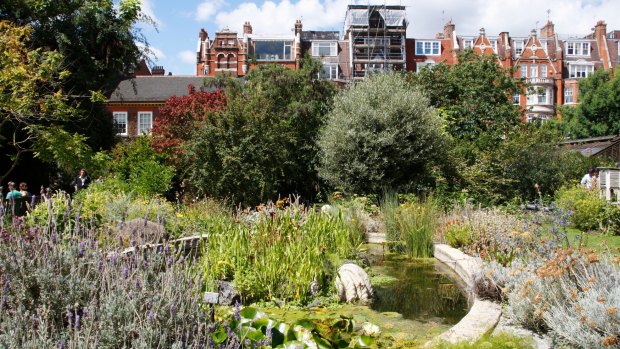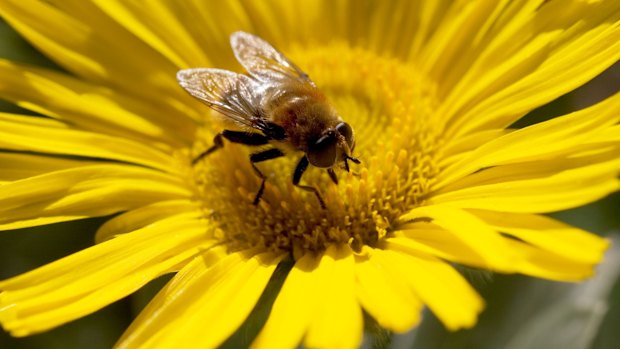This was published 5 years ago
Chelsea Physic Garden, London: A historic botanical treasure
By Keith Austin

Hidden highlight: Chelsea Physic Garden.Credit: Alamy
It's not easy photographing bumble bees but I'm giving it a red-hot go. I came here for the flowers but instead I'm trying to focus on a bee and I'm surprised to find myself oddly, genuinely fond of my subject.
Perhaps it's some Proustian memory of British childhood; the few warm days of summer holidays, the peel of sunburnt skin, the oily slick of Ambre Solaire and the gentle drone of the fat bees that we just don't get in Australia.

The place is buzzing.Credit: Alamy
The preponderance of these jolly black-and-yellow bundles is a happy corollary to our visit to the Chelsea Physic Garden, one of the oldest botanical gardens in Britain.
Established in 1673 by the exquisitely named Worshipful Society of Apothecaries to grow plants to be used as medicines, it was a jealously guarded secret until it became a registered charity in 1983 and opened to the public for the first time.
Since then it's managed pretty much to remain hush-hush – a patch of greenery within walking distance of Sloane Square and Battersea Park that even many Londoners don't know about.
The bees, do, however. And can you blame them? After all, there are some 5000 plants and flowers in here ranged across such distinct areas as the Garden of Medicinal Plants, the Pharmaceutical Garden, the Garden of World Medicine and the Garden of Edible and Useful Plants.
The 3.5-acre triangular garden is enclosed by a high brick wall that extends along Chelsea Embankment, Swan Walk and Royal Hospital Road (just metres from Restaurant Gordon Ramsay, if the lunch in the garden's little Tangerine Dream cafe isn't good enough for you).
The entrance in Swan Walk is an understated opening in the wall guarded only by a wrought iron gate. Just inside there's a small wooden hut where a volunteer takes your £10.50 ($18) and issues a ticket.
What opens up thereafter is a petite pocket of horticultural delight that manages to be entertaining, educational and endlessly fascinating. It also has a delightful sense of humour, as we realise when the first sign we come across declares it is about the Swedish "botanical pornographer" Carl Linnaeus.
Before 1753 botanists used descriptions that were up to 13 words long to make sure they were talking about the same plant. Then along came Linnaeus with a two-name system based on the arrangement of the sexual organs of the plants. This sexual shorthand led to him being pilloried at the time but the system stuck and today Linnaeus is known as the father of modern taxonomy.
With no goal in mind we saunter along the narrow gravel paths, taking in a flower here or a plant there. Someone has planted a teapot in the tea leaves section and in one corner we come across a small battalion of wooden beehives, one of which is emblazoned with the words "bees need flowers, flowers need bees".
In the Garden of Useful Plants (Hygiene and Cosmetics section) we are introduced to the plants used to make "soaps, toiletries and domestic cleaning products". These include Calendula Officinalis (the pot marigold to me and thee) that is used in perfumes, skin lotions and "hair lightening shampoos".
We also come across an old wooden bench that bears a polite sign saying: "Please do not sit on this bench as it will damage the lichen which are being studied by the education department."
My favourite section is the poisonous plants area, where the signs are adorned with a classic skull-and-crossbones logo and where we learn that touching the Heracleum Mantegazzianum (giant hogweed) can cause the skin to blister when subsequently exposed to sunlight and that all parts of the Himalayan Monkshood (Aconitum Ferox) are deadly.
And, of course, there are the bees.
TRIP NOTES
MORE
FLY & TUBE
All major airlines fly to London.
The gardens are at 66 Royal Hospital Road, Chelsea, SW3 4HS and the nearest Underground station is Sloane Square (District and Circle lines).
VISIT
The Chelsea Physic Garden is open Monday to Friday, Sundays and Bank Holidays. It is closed on Saturday. Adult tickets cost £10.50 and children under five are free. Family tickets are available. The garden and the shop are open 11am-6pm. During July and August, the garden and cafe are open until 10pm on Tuesdays and Wednesdays, with last entry at 8.30pm. Entry to the garden is £5 from 6pm-8.30pm on those days. For more details and a downloadable watercolour map of the garden, see chelseaphysicgarden.co.uk
Keith Austin visited the gardens at his own expense.
See also: Six of the best parks in London
See also: The London spot Sir David Attenborough calls 'breathtakingly beautiful'
Sign up for the Traveller Deals newsletter
Get exclusive travel deals delivered straight to your inbox. Sign up now.